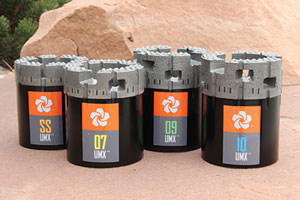
|
| A good core driller knows how to strike a balance between wear on bit and getting the job done. Source: Boart Longyear |
Another critical consideration when selecting a bit is the ground formation. It is important for drillers to perform appropriate research to determine what lies beneath the surface. Ground formations are generally gauged on a hardness scale. The Mohs scale measures hardness on a range from 1 to 10, with 10 being the hardest. The hardness of the ground should be measured in selecting the appropriate impregnated bit formula.
While taking into account the driller’s experience, the equipment and the ground formation, contractors should choose the bit based off hole and core size. Bits with extended diamond crowns can significantly improve productivity through reduced rod tripping as the bit stays in the hole longer. Extended crown bits with formulas made for broken formations, like the Boart Longyear Stage waterway designs, can generate even higher efficiency and production by advancing the hole farther in challenging conditions.
For soft formations, large natural diamond surface-set bits were traditionally used and recommended. Unfortunately, when surface-set bits encounter hard ground, the driller needs to trip the drill string to change to an impregnated bit. The Boart Longyear SSUMX diamond impregnated bit has enabled drillers to get the penetration rate of a surface-set bit in soft formations, while still being able to drill hard rock formations without having to trip the drill string. The SSUMX can handle some of the softest formations, such as coal (1 on the Mohs scale), while also handling formations as tough as granite (up to 6 on the Mohs scale).
When drilling deep holes, the bit can encounter a wide range of ground formations. Utilizing a bit that can handle the varied hardness of the ground is a benefit to the efficiency of the driller. Diamond impregnated bits are typically chosen for their ability to penetrate specific rock conditions. The Boart Longyear family of Ultramatrix (UMX) diamond core bits is designed to drill efficiently in a wide range of drilling conditions and ground formations through its patented technology.
Our 07UMX bit is chosen to handle anything from limestone to taconite (3 to 8 on the Mohs scale) and the 09UMX tackles slate to iron ore (4 to 9 on the Mohs scale). The UMX bits are designed to self-sharpen through the innovative crown matrix, which wears away to form a reinforcement of newly exposed large diamonds. This allows drillers to keep drilling through different types of formations without pulling out of the hole to change to a different bit. The 10UMX is designed to penetrate the hardest rock formations encountered (8 to 9 on the Mohs scale) and offers the freest-cutting matrix available.
The UMX bits also feature the patented Boart Longyear Stage waterway design, crown heights up to 25 mm and Twin-Taper window design. With the unique Razorcut technology, UMX bits can begin cutting right out of the box, even in overburden.
Boart Longyear has been developing innovative diamond core drilling technology for more than 80 years. Our diamond products were originally developed in the 1930s by Boart Products and used to explore for copper and gold in Africa. Shortly after, Longyear contract drilling began using cast set diamond bits. The early success of these bits led to widespread adoption of the technology within the industry. During the 1970s, Boart Longyear engineers secured a reliable source of high-performance synthetic diamonds which launched the development of the revolutionary impregnated diamond bit.
As we observe our 125th anniversary in 2015, we at Boart Longyear remain dedicated to diamond coring innovation that will enable drillers to maximize productivity and cost savings for years to come.
Monika Portman is director of product management for Boart Longyear. Contact her at monika.portman@boartlongyear.com.





Report Abusive Comment